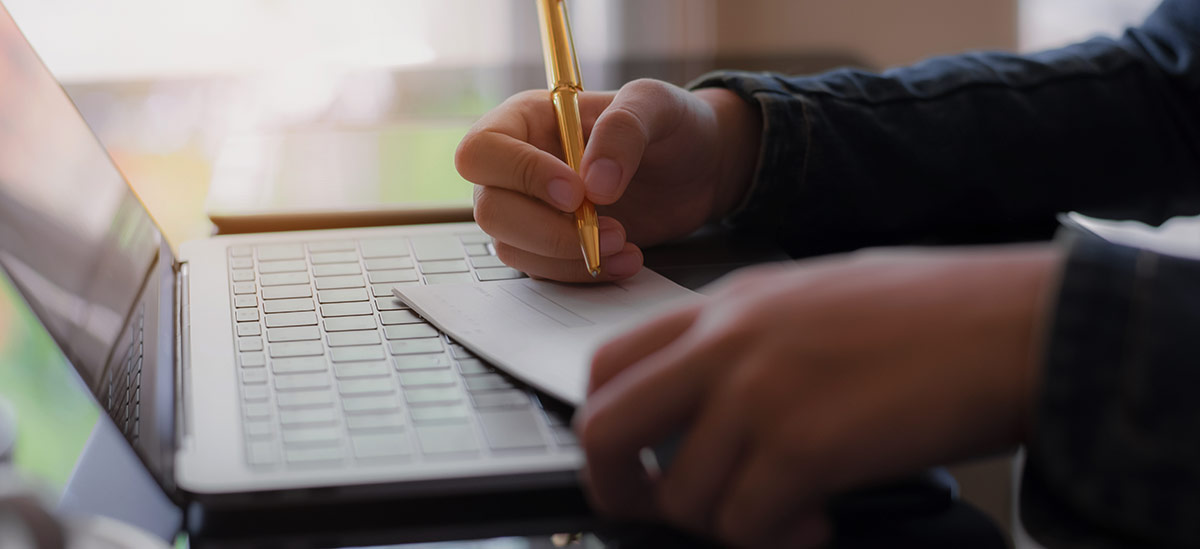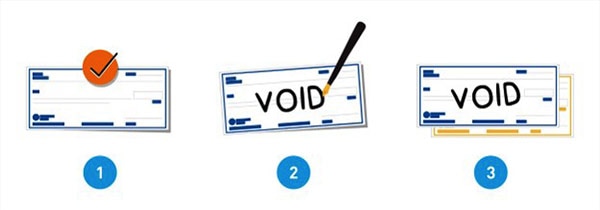
Dealing with paper checks may be unfamiliar territory for some in an era of digital banking. However, there may come a time when you may need to void a check, such as setting up a direct deposit, preventing fraud, or correcting errors made when writing a check.
It is important to understand some everyday situations where you may need to know how to void a check and how to do it properly. It's another way to help ensure your bank account is safe and secure. Here's what you need to know.
What Is A Voided Check?
A voided check is a paper check with the word "VOID" written across the middle portion of it, with the account number and bank's routing number still showing. This allows those who need your account information, like an employer, to have it, but it ensures no one can use the check.
Voiding a check and then disposing it properly helps ensure your bank account information stays secure. When a check is voided, it's invalid. It can't be used for deposits or payments. And writing void on the check helps prevent others, including thieves, from filling out a blank check and using it to make a payment or withdraw money from your account.
The Proper Way To Void A Check
Voiding a check is straightforward and involves just a few steps.
1. Use a pen with blue or black ink. It helps ensure the markings are clear and noticeable. Other color inks may not show up correctly on the check.
2. Write VOID in large capital letters across the front of the check. Write it big enough so it covers the majority of the check. However, make sure you can still see the account and routing numbers at the bottom of the check.
3. Don't sign a blank check. Adding your signature may create confusion, so leave that line blank. If you've already signed the check, it can still be voided via steps one and two — writing VOID in large letters with blue or black ink.
4. You may also want to make a copy of the check if you need it for future reference.
If you keep track of your checks in a register or spreadsheet, note the voided check number and the date. That helps you keep track of this check, so you know exactly what happened to it in the future or if you can't remember which check number you've voided.

Why Void A Check?
Even if you rely on digital banking for your transactions, there are some common instances where you'll need to know how to void a check, including:
Setting Up Direct Deposits
When starting a new job, you might have the option of receiving your paycheck via direct deposit. To set that up correctly, your employer may need a voided check for the bank account where the funds should go. The voided check provides all your necessary banking information and removes the risk it may inadvertently be used for a transaction.
Setting Up Automatic Payments
Today, it's common for many people to set up automatic monthly payments for car payments, utility bills, or mortgages. To set that up, the company may request a voided check to ensure they have the correct banking details.
Verifying Banking Information
In some scenarios, such as leasing an apartment, a landlord may ask to provide proof of a valid bank account before finalizing the agreement. Providing a voided check can fulfill this requirement without risking any transactions.
Correcting A Mistake
Sometimes, you make a mistake, like writing the wrong amount. When that happens, voiding the check helps ensure you know it's a mistake and don't accidentally use it.
Keep in mind that once you have given a check to the payee, it can't be voided. At this point, the only way to prevent the check from being cashed or deposited is to ask your bank for a stop payment, which may come with a fee.
How To Dispose Of A Voided Check
Voiding a check doesn't make it useless to fraudsters. The check still has your bank account and routing number, which means that if identity thieves get their hands on it, they could try to access your bank account or fraudulently steal funds. Check washing is also a practice where thieves have been known to erase ink on the check with chemicals. So you want to avoid throwing the check in the trash as is.
Instead, consider some of these safer methods of check disposal:
- Shredding: One way to dispose of a voided check is by shredding it. Cross-cut shredders are ideal for cutting paper into tiny, unreadable pieces.
- Tearing: If you don't have a shredder, rip the check into tiny pieces, especially the portion displaying your account and routing numbers.
- Secure trash services: Some companies offer secure trash disposal services, guaranteeing that any document you provide will be safely and effectively destroyed.
Common Mistakes When Voiding A Check
Voiding a check is a simple process, but mistakes happen. These oversights might appear minor but can lead to confusion or potential security risks.
- Partial voiding: Writing "VOID" too lightly or too small might not deter someone from fraudulently attempting to use the check. Or, a partially voided check can be confused with an active check if it's not visibly distinct.
- Not recording: Failing to note the voided check can lead to confusion when balancing a checkbook or reviewing monthly bank statements. You might wonder why there's a missing check number or second-guess yourself.
- Discarding instead of destroying: A voided check still contains sensitive information, such as your account and routing numbers. If it lands in the wrong hands, it can be used for fraudulent activities or identity theft.
Awareness of these common mistakes and avoiding them helps ensure your financial details remain secure and your records stay accurate.
Add Digital Tools To Your Checking Account
In a world rapidly transitioning to digital transactions, the check still matters in certain aspects of our financial lives. Knowing how to void a check correctly ensures safety and protects your bank account information.
Are you considering opening a checking account? Explore PNC's Virtual Wallet Checking Accounts. These combine the benefits of a traditional checking account while adding innovative digital tools to help you plan, save, and protect your finances.
Learn more about PNC's Virtual Wallet Checking Accounts.




